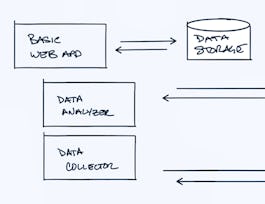This course introduces the use of statistical analysis in Python programming to study and model climate data, specifically with the SciPy and NumPy package. Topics include data visualization, predictive model development, simple linear regression, multivariate linear regression, multivariate linear regression with interaction, and logistic regression. Strong emphasis will be placed on gathering and analyzing climate data with the Python programming language.



Modeling Climate Anomalies with Statistical Analysis
This course is part of Modeling and Predicting Climate Anomalies Specialization

Instructor: Osita Onyejekwe
Sponsored by InternMart, Inc
Recommended experience
What you'll learn
Visualize and interpret climate anomalies using statistical analysis.
Use APIs to import climate data from government portals.
Visualize data in Python with matplotlib.
Details to know

Add to your LinkedIn profile
3 assignments
See how employees at top companies are mastering in-demand skills

Build your subject-matter expertise
- Learn new concepts from industry experts
- Gain a foundational understanding of a subject or tool
- Develop job-relevant skills with hands-on projects
- Earn a shareable career certificate


Earn a career certificate
Add this credential to your LinkedIn profile, resume, or CV
Share it on social media and in your performance review

There are 3 modules in this course
In this module, we'll start with an introduction to the Python library, Pandas. You'll also learn the fundamentals of data visualization using Matplotlib, a powerful library for creating insightful plots and graphs. At the end of the module you will practice manipulating data with Pandas and visualizing your findings using Matplotlib.
What's included
4 videos4 readings1 assignment1 programming assignment
In this module, you will be introduced to APIs and the Python requests library, enabling you to connect and interact with web-based data services. You'll explore climate data sources from NOAA, USGS, and NWIS, and practice accessing data using the dataretrieval library.
What's included
4 videos6 readings2 assignments
In this module, you will delve into visualizing and analyzing various climate data sets, including air temperature, precipitation, groundwater level (GWL), and soil temperature and moisture. You will learn to create informative visualizations to identify patterns, trends, and anomalies in the data.
What's included
4 videos1 programming assignment1 peer review1 discussion prompt1 ungraded lab
Instructor

Offered by
Why people choose Coursera for their career




Recommended if you're interested in Data Science

University of Colorado Boulder

University of Colorado Boulder

University of Michigan

University of Colorado Boulder

Open new doors with Coursera Plus
Unlimited access to 10,000+ world-class courses, hands-on projects, and job-ready certificate programs - all included in your subscription
Advance your career with an online degree
Earn a degree from world-class universities - 100% online
Join over 3,400 global companies that choose Coursera for Business
Upskill your employees to excel in the digital economy


